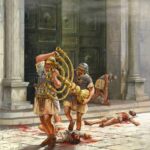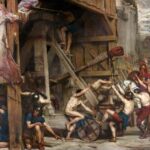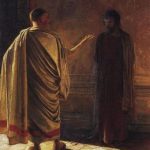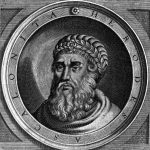Chapters
Bar-Kokhba uprising was the third Jewish uprising against Roman rule in 132-135 CE.
Background of events
After a failed Jewish War in 70 CE Roman authorities took steps to pacify the rebellious province of Judea and romanize it. In place of the prosecutor, a praetor was appointed administrator and the X Fretensis legion was permanently placed. In the meantime, there was another conflict between the Jews and the Romans – the so-called Quietus’ wars – which took place in the years 115-117 CE
In 129 CE Roman Emperor Hadrian issued an order to build the temple of Capitoline Jupiter on the site of the demolished Temple in Jerusalem. The city of Jerusalem was to be completely rebuilt according to the Hellenistic pattern and to serve as a Roman colony. At that time, the VI Ferrata legion was also placed in the region to help keep order. In 131 CE the idea of the governor of Judaea, Quintus Tinnaeus Rufus, came up with the idea of renaming Jerusalem Aelia Capitolina, which met with great opposition from the Jewish population.
The flashpoint was forbidding the Jews, under penalty of death, of the circumcision ceremony (brit milah), which the emperor saw as a form of self-mutilation of the same kind as castration. This prohibition, the refusal to rebuild the demolished temple in Jerusalem and the desire to transform Jerusalem into a Roman colony certainly contributed to the outbreak of the uprising. Yet another reason could have been the emperor’s departure from the East and his persecution of the Jewish religion.
The most important historical sources for the creation of Bar-Kohba are, first of all, the accounts of Cassius Dio, Eusebius of Caesarea, “Historia Augusta” (in Hadrian’s biography), as well as Talmudic sources. The uprising is not as well known to us as it was in 70 CE, due to the fact that “another Josephus Flavius” did not take part in the action.
Rise
The leader of the uprising, with the title “Prince of Israel”, was Simon ben Koziba (aka Simon Bar-Kohba), and his uncle Eleazar, son of Charsom, became the chief priest. Both leaders were from the Hasmonaean bloodline. The whole situation came about when the Jewish rabbi and sage, Akiba ben Yosef, recognized Simon as the Jewish Messiah and gave him the name “Bar Kohba”, meaning “son of the star” in Aramaic.
The entire war was carefully planned and thought out by the Jewish commanders so as to rule out mistakes made during the First War, sixty years earlier. Officially, the revolt broke out on April 3, 132 CE. (according to the letters of Bar-Kohba). The fighting quickly moved from Modi’in to the entire province, so that the Roman garrison in Jerusalem was cut off.
As a result of the fighting, the Jews liberated the entire area of the province, including Jerusalem and the ruins of the Temple, where the sacrificial service was resumed. In total, the insurgents captured about 50 fortresses and about 1,000 towns and villages. The fights were very fierce and the losses of the Romans were enormous.
The Rising took the Romans by surprise. Emperor Hadrian summoned from Britain General Sextus Julius Sever and Quintus Lollius Urbikus, and troops were brought as far as the Danube and Spain. The Roman army assembled to pacify the revolt was much larger than the army of Titus in 70 CE. Interestingly, the losses of the Romans were also much greater. The legion of XXII Deiotariana was disbanded after a series of heavy defeats. It is also suspected that serious losses in Legio IX Hispana caused that in the middle of the 2nd century CE branch was disbanded. The following legions also took part in the war: VI Ferrata, X Fretensis, II Trajan Fortis; and individual legion units (probably): III Cyrenaica, III Gallica and IIII Scythica. For the first time in a hundred years, Rome needed additional recruits; for this purpose, two senators recruited young men.
In 135 CE The Romans entered Judea, starting fights against the Jewish insurgents. They used the usual Roman tactic of dividing, isolating and liquidating subsequent insurgent enclaves, which was also used in 70 CE
During the Bar-Kohba uprising, the rebels used the most important means of propaganda and issued their own coins on the coins that were currently in circulation in Judea and the region. This was due to problems related to military operations and the lack of metal. In addition, the following images appeared on the coins: the facade of the Jerusalem temple, palm branches, myrtle and willow. Also temple vessels and instruments: pitcher and amphora, harp and lyre. Hybrid coins also appeared: one side represents year one, and the other side represents year two, three, and even four.
In the summer of 135 CE, Roman legionaries captured Jerusalem. The entire operation to pacify the province took the Roman legions three years. The commander of the insurgents Bar-Kohba, after losing more fortresses, retreated with the remnants of the army to the city of Bethar, which was besieged. As the last point of resistance in Galilee, the headquarters of the insurgents, located southwest of Jerusalem (also the seat of the Sanhedrin), fell. The described events took place in November 135 CE. The end of the uprising is considered to be November 6, 135 CE, because that is when the last letter of the commander Simon comes from.
Consequences
According to Cassius Dio, 580,000 Jews died and 50 fortresses and 985 villages were captured. The prisoners were sold in Hebron and Gaza as slaves, each for the price of a horse. The Temple Mount in Jerusalem was ploughed. There was a temple of Jupiter and a statue of Hadrian. The city was named Colonia Aelia Capitolina and made it a colony for the deserving Syrian and Phoenician soldiers. The practise of Judaism was forbidden. The country was renamed from Judea to Syria Palestina (“Palestinian Syria” or Philistine). In former Jerusalem, pagan temples were built in honour of Jupiter, Serapis, Dionysus, and Castor and Pollux. Jews were forbidden to live, enter or stay in the vicinity of the city, and they could only enter the temple grounds on the 9th day of Av to mourn their misfortune at the Wailing Wall. During the reign of Hadrian’s successor – Antoninus Pius – the attitude to the Jewish religion was liberalized. The burial of the dead has been allowed and the law against circumcision has been abolished.
In the years and centuries that followed, more Jewish uprisings broke out, but in most cases were quickly suppressed. This uprising is believed to have contributed greatly to the times of the diaspora. In the 1st and 2nd centuries CE, after two more Jewish uprisings, the Romans decimated the Jewish population and liquidated the independent kingdom. From then on, the overwhelming majority of Jews lived outside Palestine.










